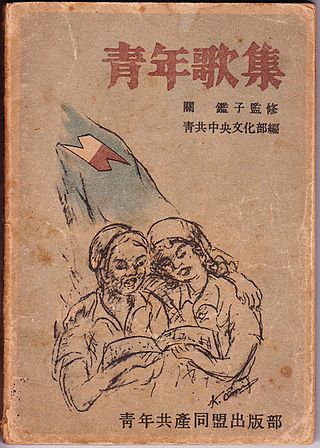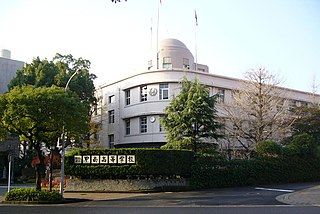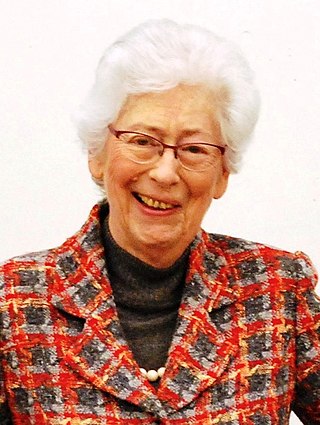Interpreting is a translational activity in which one produces a first and final target-language output on the basis of a one-time exposure to an expression in a source language.
The American Translators Association (ATA) is the largest professional association of translators and interpreters in the United States with nearly 8,500 members in more than 100 countries.

The United Nations Associations Test of English is a standardized test of English administered by the United Nations Association of Japan, a public interest incorporated foundation. It is supported by the Ministry of Foreign Affairs of Japan.
Mari Yonehara was a Japanese translator, essayist, non-fiction writer, novelist, and simultaneous interpreter between Russian and Japanese, best known in Japan for simultaneous interpretation in 1980s and 1990s and writing in 2000s.
The Japan Association of Translators (JAT) is the largest professional association of practicing translators and interpreters in Japan, with approximately 800 members. The association was founded in 1985.

There are two main translations of the Bible into Japanese widely in use today — the Japanese New Interconfessional Translation Bible (新共同訳聖書) and the New Revised Bible (新改訳聖書). The New Japanese Bible, published by the Organization for the New Japanese Bible Translation (新日本聖書刊行会) and distributed by Inochinokotoba-sha, aims to be a literal translation using modern Japanese, while the New Interconfessional Version, published by the Japan Bible Society, aims to be ecumenically used by all Christian denominations and must therefore conform to various theologies. Protestant Evangelicals most often use the New Japanese Bible, but the New Interconfessional Version is the most widely distributed and the one used by the Catholic Church, the United Church of Christ, Lutheran Church factions and many Anglicans in Japan.
An interpreter officer or army interpreter is a commissioned officer of an armed force, who interprets and/or translates to facilitate military operation. Interpreter officers are used extensively in multinational operations in which two or more countries that do not share a common language are undertaking a joint operation, or expeditionary missions in which the communication with the local population is crucial but limited by lack of language proficiency among the expeditionary force personnel. Interpreter officers also work in the intelligence gathering and analysis though in many countries, civilian analysts are used instead of the officers in active duty.

The International Association of Conference Interpreters - AIIC was founded in 1953. It represents over 3,000 members present in over 100 countries.
Jun Watanabe is a Japanese architect and a former professor at Chubu University.

Qian Daosun (1887–1966) was a Chinese writer and translator. His renowned translations include the Inferno part of the Divine Comedy, Man'yōshū and The Tale of Genji. Qian was born in a family of officials and scholars.

The Singing Voice of Japan is the name of a social and political movement that emerged after World War II in Japan and based on musical and choral activities of the working class of the entire nation. On the ideological position of communism or democratic socialism, activists of the movement organize choral circles in factories, in schools and in their residential areas. The movement reached its peak in the years 1950–60. Japanese singer Akiko Seki is generally regarded as the founder of the Singing Voice of Japan.

The Japan Medical Association, is the largest professional association of licensed physicians in Japan. The JMA has been a member of the World Medical Association since 1951 and participates at all levels of the WMA. National headquarters are located in Honkomagome, Bunkyō, Tokyo, Japan, supplemented by prefectural branch offices and member associations in local communities.

The Japan Pharmaceutical Association is the peak national professional association representing pharmacists in Japan. Pharmacists who join their prefectural and local municipality professional organisations automatically gain membership in the JPA. The association was founded on June 11, 1893 by Ogimachi Sanemasa.
The Japanese Association of Medical Sciences is a suborganization of the Japan Medical Association (日本医師会) devoted to the development and promotion of science and research in medicine. The Japanese Association of Medical Sciences was founded independently of the Japan Medical Association in 1902 as a collaboration between 16 medical societies in Japan. Since their founding, they have held a general assembly called the Japan Medical Congress every four years except in 1947 when it was postponed for a year due to the Second World War. In 1948, they held their twelfth assembly at which point they merged with the Japan Medical Association, which has remained their parent organization since. Rather than individuals, the Japanese Association of Medical Sciences has member societies. As of 2019, they have 132 member societies.

Kagoshima Prefectural Konan Senior High School is an upper secondary school in Kagoshima City, Kagoshima Prefecture, Japan. It is a co-educational public school.
The Japan Bible Society Interconfessional Version (JBSIV) is a Japanese translation of the Bible published in 2018 by the Japan Bible Society. It is a revision of the New Interconfessional Translation Bible (NIT) of 1987, the first revision in 31 years.

Marianne Lederer (born 1934) is a French translation scholar. Lederer further developed the Interpretive Theory of Translation together with Danica Seleskovitch, who first proposed the theory. Lederer also published several works on translation and interpreting pedagogy. Her works have greatly influenced interpreting and translation research and teaching internationally.









